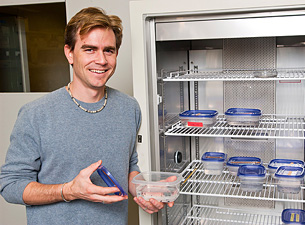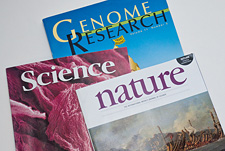Feature Story
Health Center Today, December 23, 2010
UConn Scientists Expand Understanding of Human Genome
By David Bauman

Brenton Graveley in his lab at the UConn Health Center. Graveley oversees the Health Center’s Translational Genomics Core.
Photo by Peter Morenus
UConn Health Center scientists participating in a National Institutes of Health (NIH) research consortium to analyze the genomes of the common fruit fly and a tiny worm have made several discoveries that promise to reshape scientific understanding of how the human genome functions.
The findings of UConn geneticist Brenton Graveley and his team will be published this week in three highly-respected peer reviewed journals: Science, Nature, and Genome Research.
The publication of Graveley’s academic work in three journals at the same time underscores the significance of his scientific contribution to understanding the human genome.
The human genome is a map made up of some 3 billion “letters” of the four-letter DNA alphabet lined up in a well defined sequence that are a cell’s instructions for making a human being. Both the fruit fly (Drosophila melanogaster) and the roundworm share many genetic similarities with humans, yet their genomes are far easier to work with in experimental settings.
Because all diseases have a genetic component, it is believed that knowledge of the genome’s precise sequence of DNA units will lead to significant advances in many branches of medicine.
“The importance of the work of Dr. Graveley and his collaborators cannot be understated,” said Marc Lalande, senior associate dean for research planning and coordination at the Health Center and director of UConn’s Stem Cell Institute.
“This successful endeavor shows that groups of scientists from different places around the country can work together to discover the network of gene interactions needed to design and develop a complex living organism,” Lalande said.
Noting that the consortium involves experts in biology, genetics, computer science, and mathematics, he said it is likely that this sort of multidisciplinary approach could also illuminate how gene networks are disarrayed in diseases such as cancer, Alzheimer’s disease, and autism.

Graveley has papers in three highly respected journals: Nature, Science, and Genome Research.
Photo by Sean Flynn
The Nature paper details how Graveley and his colleagues determined which genetic sequences are functional – which genes were on or off – at 30 points over the course of the fruit fly’s lifespan. During the process, they identified nearly 112,000 new biological elements needed for the fruit fly to develop and thrive.
The Science paper, led by Manolis Kellis of MIT, builds on the Nature paper and provides high quality maps of the existing and newly discovered functional elements in the fruit fly’s genetic sequence that should aid efforts to understand such processes in the human genome.
Graveley, a professor in the Health Center’s Department of Genetics and Developmental Biology, said the researchers learned that “the number of building blocks used to build a fly" is much greater than once thought. He noted that further work on the function of these new elements will provide valuable insight into animal development, including that of humans.
Graveley – who has an international reputation in comparative genomics, data integration, and data visualization – oversees the Health Center’s Translational Genomics Core. This facility is equipped with the state-of-the-art technology necessary to read entire genomes, and conduct DNA analysis and sequencing, gene expression analysis, and genotyping.
In recent years, new technologies have shown that the DNA sequence is more than a series of genes, but a variety of functional elements, or sequences, that serve as ignition switches, brakes, and accelerators for gene expression. It has become apparent that some genes are involved in coding for multiple proteins through a process known as “alternative splicing,” which can generate more complex sequence patterns from a single gene than the number of genes in the entire genome.
“Now we know that alternative splicing is the rule, not the exception, and plays an extremely important role in expanding protein diversity and might explain the apparent discrepancy between gene number and organism complexity,” he says.
Graveley and his lab members are one of six teams participating in a project called model organism ENCODE (modENCODE), funded by the NIH’s National Human Genome Research Institute, to identify and conduct experiments on functional elements in the genetic sequences of model organisms such as the fruit fly and the roundworm.
Data from this project will complement another NIH project, the Encyclopedia of DNA Elements (ENCODE), which focuses on the human genome.
“The fruit fly is the ideal model for the study of functional regulatory elements in the human genome,” Graveley says. “It shares the structure and many features of the human genome; many human proteins function just as well in fruit flies. Yet it is small enough for high-resolution, genome-wide analysis.”
The new data generated by the modENCODE consortium contribute to the emerging view that many different combinations of DNA sequences control patterns in the way genes are expressed in the fruit fly genome.
The group involved in the Nature paper was led by Graveley and U.S. Department of Energy’s Lawrence Berkeley National Laboratory’s Susan Celniker, and includes research teams led by Peter Cherbas of Indiana University, Bloomington; Tom Gingeras of Cold Spring Harbor Laboratory; Norbert Perrimon of Harvard Medical School; Michael Brent of Washington University in Saint Louis; and Steven Brenner of the University of California at Berkeley.


